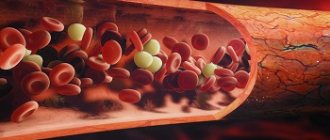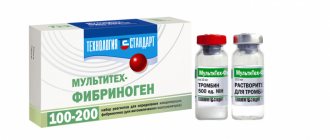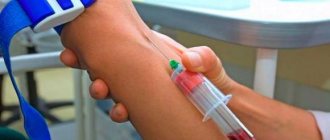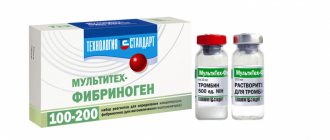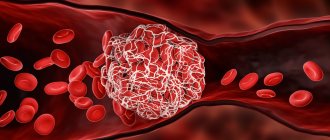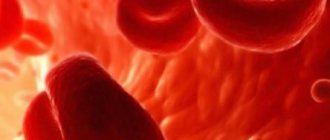The activated partial thromboplastin time (aPTT) test characterizes the state of one of the three mechanisms of the hemostatic system - coagulation (blood clotting). Using the APTT analysis, all types of hemophilia are diagnosed - A, B and C, as well as hereditary, autoimmune diseases and the phases of DIC syndrome are determined.
You can take the APTT test and get reliable results with a transcript of the analysis in the Laboratory of Hemostasis Pathologies at the MLC, the base clinic of Moscow State Medical University named after. Sechenov.
When is an APTT test prescribed?
APTT is part of the blood tests for hemostasis, which are taken when planning pregnancy. The test is also prescribed for genetic predisposition to thrombosis, spontaneous bleeding of unknown origin, diagnosis of hemophilia, treatment of heart attack, during pre- and postoperative examinations.
Based on the results of the analysis, the presence of coagulation inhibitors is determined - signs of systemic lupus erythematosus and antiphospholipid syndrome, severe autoimmune pathologies. The APTT test is also used to monitor heparin therapy.
Normal indicators
| Index | Reference value | Unit |
| Prothrombin time | 9,0–15,0 | sec. |
| Prothrombin according to Quick | 78–142 | % |
| INR | depends on the presence of concomitant pathology in the patient for which he receives anticoagulant therapy | |
| APTT | 25,4–36,9 | sec. |
| Thrombin time | 10,3–16,6 | sec. |
| Fibrinogen | 2,00–4,00 | g/l |
| up to 5.6 (2nd and 3rd trimester of pregnancy) | g/l | |
Benefits of analysis
APTT is a highly focused study that diagnoses several pathologies of hemostasis. The coagulation mechanism of hemostasis ensures the “sealing” of damage in blood vessels with fibrin clots and is influenced by blood coagulation factors.
Using the APTT test, you can detect a deficiency of the main factors affecting coagulation:
- 2nd, prothrombin;
- 5th, proaccelerin;
- 8th, antihemophilic globulin;
- 9th factor;
- 10th, Fr. Stewart-Prower;
- 11th, Dr. Rosenthal;
- 12th, Dr. Hagemann.
Coagulogram (screening)
No. OBS103Comprehensive studies
Hemostasiogram (coagulogram), screening Synonyms: Hemostasiogram, coagulogram. Coagulation studies (coagulation profile, coag panel, coagulogram). Brief description of the study “Hemostasiogram (coagulogram), screening” Includes the following indicators: Prothrombin (prothrombin time, prothrombin (according to Quick), MN...
Up to 1 business day
RUB 1,360
No. OBS109Comprehensive studies
Hemostasiogram (coagulogram) extended Synonyms: Hemostasiogram. Coagulation studies (coagulation profile, coag panel, coagulogram). Brief characteristics of the study “Hemostasiogram (coagulogram) extended” Coagulation link of hemostasis: Prothrombin (prothrombin time, prothrombin (according to Quick)…
Up to 1 business day
RUB 3,790
You can take a coalogram at the nearest INVITRO medical office. A list of offices where biomaterial is accepted for laboratory research is presented in the “Addresses” section.
The blood coagulation system is primarily an enzymatic system that provides external, internal and general coagulation pathways. These mechanisms are successively replaced, but they can also occur independently of each other.
The screening coagulogram includes the following indicators:
- prothrombin (prothrombin time, prothrombin (according to Quick), INR - international normalized ratio);
- fibrinogen;
- APTT (activated partial thromboplastin time);
- thrombin time.
These indicators are basic and allow you to evaluate all coagulation pathways.
Decoding
The standard for the test is 24-35 seconds. Physiological changes in hemostasis occur in the body of expectant mothers, so the APTT during pregnancy is reduced to 17-20 seconds. The type of pathology is determined based on the shortening or lengthening of the APTT.
What does it mean if APTT is higher than normal?
Prolongation of APTT is a sign of deficiency of blood coagulation factors: 8th in hemophilia A, 9th in hemophilia B, 11th in hemophilia C, as well as von Willebrand disease - an inherited tendency to spontaneous bleeding.
If the marker increases, additional tests are performed for lupus anticoagulant and antiphospholipid syndrome, and if the patient receives heparin injections, the dose of the drug is adjusted.
What does it mean if APTT is below normal?
A shortening of the activated partial thromboplastin time indicates the risk of developing thrombosis - blockage of blood vessels, or thromboembolism - a blood clot breaking off and entering the circulating blood. Low aPTT determines the first phase of disseminated intravascular coagulation.
If venous blood is collected incorrectly or the sample is contaminated, a decrease in the marker is also observed - in such cases, the analysis is repeated.
Indications for the purpose of the study
Coagulogram (hemostasiogram) is a comprehensive hematological study aimed at assessing the state of the hemostasis system (blood clotting), or blood clotting indicators. The hemostasis system includes blood cells (platelets) and specific substances (clotting factors) dissolved in blood plasma and contained in platelets. When the integrity of the vessel wall is violated, the coagulation system is activated and a blood clot is formed, preventing blood loss.
Some time after the bleeding stops, fibrinolysis begins - the process of dissolving the blood clot after restoring the damaged vessel wall to resume blood flow.
Indications for a coagulogram are conditions accompanied by increased bleeding or, conversely, increased thrombus formation.
Increased bleeding leads to hemorrhagic syndrome. It is manifested by the formation of hematomas, pinpoint hemorrhages under the skin (petechiae), bleeding of the mucous membranes (nosebleeds, bleeding from the gums), the appearance of blood in the stool, urine, prolonged menstrual bleeding, as well as possible hemorrhages in the internal organs and body cavities. The most dangerous manifestation of hemorrhagic syndrome is hemorrhage in the brain - hemorrhagic stroke, which can lead to rapid impairment of brain function, including death. A hereditary disease associated with blood clotting disorders (decreased or absent clotting factors) is called hemophilia.
The opposite situation - thrombosis - is the formation of blood clots (thrombi) inside blood vessels, preventing the free flow of blood.
People with obesity, diabetes mellitus, heart rhythm disturbances (the most significant of which are atrial fibrillation and flutter), low physical activity, and patients after major operations (for example, joint replacement, heart valve replacement, emergency operations, etc.) are at risk of increased thrombosis. , with varicose veins, previous myocardial infarctions, strokes, and various autoimmune diseases.
Thrombosis in a certain area of the vascular bed is accompanied by an acute or gradual disruption of the blood supply to any organ with disruption of its functions and subsequent tissue necrosis.
In addition to the above conditions, a coagulogram is performed before operations to assess the risk of bleeding, when prescribing certain medications, and also necessarily in case of liver diseases, since most of the proteins of the blood coagulation system are synthesized in this organ.
Where to get tested for APTT in Moscow
You can take an APTT test and get advice from an experienced hemostasiologist at the Women's Medical Center on Zemlyanoy Val. Our Hemostasis Pathology Laboratory has high-precision blood analyzers, high-quality reagents and consumables, which guarantees the reliability of the research results.
Along with the APTT test, you have the opportunity to take tests close to it: 2-TEG, extended hemostasiogram, tests for VA and APS, Antithrombin, and also determine the anti-Xa activity of heparin in the blood. In the experimental laboratory of the MLC, we are engaged not only in diagnostics: we research and practice new methods for treating hematological diseases.
In one of the private laboratories you are another statistical unit, but with us you are a patient who is ready to be helped by the best doctors in Moscow.
Preparation for the procedure
The essence of a coagulogram is to assess the activity of proteins of the blood coagulation system.
Therefore, proper preparation for this analysis is extremely important. Blood is taken on an empty stomach; the last meal should be at least 8-10 hours before the test. It is recommended to exclude excess amounts of fatty, sweet and protein foods. The drinking regime remains normal. The day before it is necessary to avoid stressful loads and intense sports. If the patient is taking any medications that affect coagulogram parameters, then, depending on the goals set for the study, it is necessary to either continue or stop taking them a few days before. This should be discussed with your doctor before taking the test.
If you need urgent results, you can contact the INVITRO offices, where express diagnostics are carried out. In this case, the analysis will be ready in about 2 hours.
Some of the proteins of the blood coagulation system are acute phase proteins. They are produced during stress, which includes not only physical and emotional stress, but also illness. Consequently, any persistent or short-term, but intense stress in the body can lead to changes in coagulogram parameters.
Dehydration (dehydration) is one of the reasons for blood thickening and an increase in the concentration of coagulation factors, which also leads to a distortion of the result.
The state of the blood coagulation system changes during pregnancy, both in the direction of increasing and decreasing the activity of a number of proteins.
The use of many medications affects the blood coagulation system. Thus, the first generations of oral contraceptives lead to an increased risk of thrombosis, and anticoagulants lead to bleeding. The list of drugs that affect the activity of the coagulation system is huge. When receiving any drug therapy, you should first consult with your doctor about the possible effect of a particular drug on the test result.
Taking certain medications by a pregnant woman, for example, warfarin, rifampicin, phenytoin, barbiturates, affects the production of clotting factors in the fetus. The child may subsequently be at high risk of bleeding.
General information
Every qualified doctor knows that it is best to begin the treatment of any patient by collecting an anamnesis, which is nothing more than a collection of information about the state of a person’s health.
As a rule, any medical examination begins with asking the patient himself about previous diseases or surgical interventions, allergic reactions or hereditary predisposition to certain ailments, and so on.
Then the doctor prescribes a series of laboratory tests or simply tests that will help supplement the anamnesis with information about the development of the disease, as well as information necessary for choosing a treatment method or further diagnosis.
Coagulological studies (abbreviated as coagulogram ) occupy an important place among laboratory blood tests that are necessarily carried out in preparation for surgery, for example, during a planned cesarean section or during pregnancy .
Additional examinations in case of deviation from the norm
If the results of the coagulogram are unsatisfactory, the patient is recommended to undergo further examination. Its main goal is to determine the cause of violations and where they originated from. Usually a set of the following diagnostic measures is prescribed:
- General blood and urine tests
. Based on their results, it can be assumed that there are disturbances in the functioning of the liver, kidneys or hematopoietic system. - Blood biochemistry
. Particular attention is paid to the indicators of creatinine, uric acid, ALT, AST, bilirubin. The study shows pathologies in the liver and kidneys that directly affect coagulogram parameters. - Blood for tumor markers
. Beta-2-microglobulin, for example, indicates malignant diseases of the hematopoietic system. - Blood for trace elements
. A deficiency of chlorine, sodium, potassium and a number of other substances can affect the result of a coagulogram.
In some cases, genetic examinations are carried out, with the help of which it is possible to identify hereditary diseases. Hemophilia, Fillebrand's disease or Christmas disease entail changes in hemostasis. You should consult a doctor with the results of the diagnostics.
Advertising:
Standard values
Advertising:
You can donate blood for a coagulogram in both public and private clinics. Results are usually ready within 1-2 days. A doctor should decipher them. The table below shows the standard values.
| Hemostasis index | Norm |
| Clotting time | 5-10 min. |
| APTT | 30-42 sec. |
| Thrombin time | 15-18 sec. |
| Prothrombin time | 9.3-13.3 sec. |
| Prothrombin index | 70-120% |
| Fibrinogen | 2-4 g/l |
These standard values are valid for adult men and women. For children and pregnant women, these indicators will differ slightly. They also vary among older people.

